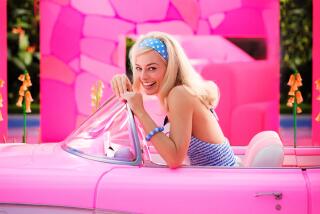Film’s new romantics
Sherlock Holmes understood the power of details.
“Details are the only things that are important,” says the super-sleuth (played by Robert Downey Jr.) in a film that opens on Christmas Day. In this instance, Holmes’ ability to assess the minutia of appearance (a band of pale skin on a ring finger) allows him to deduce that Watson’s fiancée had been married before she met the storied sidekick.
The details of clothing -- which can reveal a sense of place or status or desire -- are key to any movie, especially the serious “prestige” films that are released around the holidays.
In films such as “The Young Victoria” (in which the British queen popularizes the white wedding dress) and “Sherlock Holmes” (which reinvents the famous detective as a romantic ruffian), this season’s crop boasts trunks full of notable costume design.
Don’t expect to see a deerstalker cap and pipe in “Sherlock Holmes.”
“I thought he would be a romantic,” says costume designer Jenny Beavan, who turned to Gustave Doré’s 19th century engravings of London and the famous London costume shop CosProp for inspiration to make over the detective.
“I thought about where a guy like Holmes gets his clothes. He steals them from Watson, of course, but he also would go to vintage stores.” The result is the most rakish-looking movie character since Jack Sparrow in “Pirates of the Caribbean” -- a new, natty Sherlock in billowy white shirts, corduroy coats, silk print ascots and round wire-rim sunglasses, looking like he could have stepped off Carnaby Street.
The menswear in Tom Ford’s directorial debut “A Single Man” (opening in limited release Dec. 11) is as impeccable as the designer’s own crisp, exact collections. The film takes place during a single day in 1962 Los Angeles, as George Falconer (Colin Firth), an English professor, searches for meaning after the sudden death of his partner.
“It was clear in the script how meticulous George is,” says costume designer Arianne Phillips. “There was a fastidiousness and perfectness to the way he was planning the last day of his life.” She started her research with 1960s sack suits, then made the silhouette more appealing to the contemporary eye. Produced in Ford’s factory in Italy, Falconer’s suits manage to be both boxy and form-fitting at the same time.
The costumes on the supporting players are just as memorable. Kenny (Nicholas Hoult), a student who comes to Falconer’s emotional rescue, appears as an angel in a white mohair sweater that was modeled after one Phillips discovered in a book of 1960s street-wear photos taken by Swiss photographer Karlheinz Weinberger. “It was one of my inspiration photos for the character, so Tom suggested we make a sweater like it. We had a weaver in London do it.”
In “The Young Victoria” (in limited release Dec. 18), about the first years of Victoria’s reign and her romance with Prince Albert, the costumes are not only exquisitely detailed (think Victorian-era silks, flower headdresses and exact reproductions of coronation robes and crown jewels), they also highlight a generational divide between the young royal and her mother, the Duchess of Kent (Miranda Richardson).
The duchess is in league with a British nobleman, scheming to wrest power from the 18-year-old princess and heir to the throne. The duchess wears old-fashioned, off-the-shoulder dresses with exaggerated sleeves that suggest an old regime defined by political unrest, and the clothes stand in stark contrast to the princess’ youthful style.
After she becomes queen in 1837, Victoria’s silhouette becomes more streamlined and sophisticated, and she wears brighter colors (because new dyes were being developed at the time).
“[The change] was a backlash against the 1830s, which was about putting as much stuff as you could on a dress,” says costume designer Sandy Powell, who was able to study several of Queen Victoria’s gowns at Kensington Palace.
Using antique lace, she replicated Victoria’s famous white wedding dress. “She wasn’t one of those clotheshorses who inspired fashion,” Powell says. “But she happened to choose a white dress, and after that it became fashionable to marry in white.”
Fashioning muses
The musical “Nine” (in limited release Dec. 18), loosely based on the Federico Fellini film “8 1/2 ,” captures another rich snapshot of history -- Rome in the 1960s. Italian filmmaker Guido Contini (Daniel Day-Lewis) is facing a creative crisis, looking for inspiration for a long overdue film, and juggling the demands of the strong women who have defined his life.
Each female star of the film performs her own song, representing a fantasy in Guido’s mind, which makes for an array of lacy satin corsets, Folies Bergère-style headdresses, crystal-mesh go-go miniskirts and one standout column gown in creamy satin, worn by Claudia (Nicole Kidman), his leading lady.
“We wanted her to look like a goddess, a Greek statue,” says costume designer Colleen Atwood, adding that the boning in the dress cinched Kidman’s waist to 21 inches. “She’s the untouchable one for Guido.”
Guido’s reality is almost as decadent as his fantasies, full of the kind of fast sports cars, fluid suits, skinny ties and dark sunglasses that defined “La Dolce Vita.” (Atwood studied period photography as inspiration for Day-Lewis’ suave look, in particular the book, “A Flash of Art,” which documents paparazzi photography in Rome from 1953 to 1973.)
For “Up in the Air” (currently in limited release), whose plot follows a corporate downsizer who travels around the country firing people, costume designer Danny Glicker didn’t have history as a guide. Instead, Ryan Bingham’s (George Clooney) costumes are limited to what could fit in a carry-on bag.
“His whole outlook on life is about paring down to the essence,” Glicker says.
What made the cut? (Pay attention, frequent fliers.) One suit (the same make as the one he wears, to avoid mismatching), three white button-down shirts, two casual tattersall shirts and a pair of khakis, crushable running shoes, jogging shorts and a bathing suit, four undershirts, four pairs of underwear and socks, and jeans.
Ties are Bingham’s only means of switching it up. He shops for them in airports and stores them in a protective portfolio, doting on the bands of silk as if they were his children. To be sure, it’s an efficient approach to dressing, but the joylessness almost makes it worth checking luggage.
Glicker agrees. “The regimen that gives you so much liberation is the thing that will cage you in at the end.”
More to Read
Only good movies
Get the Indie Focus newsletter, Mark Olsen's weekly guide to the world of cinema.
You may occasionally receive promotional content from the Los Angeles Times.






